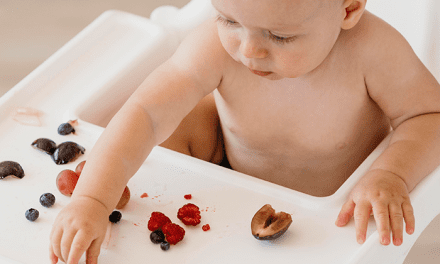Introducing solid foods in babies is a crucial step in fulfilling their nutritional requirements. Most babies develop their best on breastfeeding during their first six months and primarily do not require any solids in their diet. But until this age, the iron, vitamin A and other nutritional requirements have increased significantly. It creates a need for added iron sources to prevent anemia in infants. Additionally, consuming solid food introduces your child to many new things, such as self-feeding.
This blog will talk about a few FAQs about introducing solid food items to infants that will guide you towards better childcare practices.
What Are The Signs That The Baby Is Ready For Solid Foods?
Toddlers provide various signs once they reach a suitable age. You can look closely at a few of them, which accounts for their provisional preparation.

Keep A Close Watch On the Interpretations Your Infant Makes While Food is Around
You know you shall begin when your little one:
- Can sit alone or with the help of a support
- Tries to grasp toys and other small items.
- Open up their mouth while you offer food
- Begins to move food towards the back of the tongue, attempting to swallow
- Initiates to control their head and neck by their own
- Swallows food instead of spitting it over
- Gets objects to their jaws
How Can I Introduce Solid Foods To My Baby?
In most cases, there is no illustrated need to follow a specific pattern to introduce solid foods in babies. Your child may begin consuming food items by six months of age. By the 7th or 8th month, they can start eating a combination of food items from varied food groups. These may include cereals, fruits and vegetables, pulses, meat, dairy products such as yogurt and cheese, and more.
Try to feed a variety of grains to your kid like finger millet(ragi), pearl millet(bajra), sorghum(jowar) and other millets rather than just wheat and rice.
For detailed knowledge of what food items to feed your toddler, check out this blog on “A Comprehensive Guide On Complementary Feeding.“
Also, here are a few topics to learn before starting the solid food feeding operation.
- Get started by offering your kid only one food item at a time. It will allow you to diagnose any persistent problems such as food allergies they face with that specific food.
- Wait for a couple of days, say 3 to 4, between experimenting with any new food. This practice will finally encourage your child to enjoy a variety of new foods, perhaps earlier than your expectations!
- Ensure that you feed potentially allergic food items only after introducing other food groups. These allergenic items may include but are not limited to cow’s milk products, fish, soy, eggs, tree nuts and shellfish.
- Parents should avoid feeding cow’s milk or fortified soy beverages until their baby turns 12 months of their age. However, you can provide other cow’s milk products such as yogurt before 12 months.
- If your child has intense eczema or is allergic to eggs, consult your pediatrician and discuss how to begin foods with peanuts safely.
How shall I Start With Solid Food Preparation For My Baby?
To begin with, prepare foods that are smooth in texture and easy to swallow for your little one. You can practice mashing, squeezing, straining, and making puree for the available edibles.
- Your child may require some time to adjust to the new food consistencies. Initially, they may develop coughing, stifling, or may end up spitting the edibles. Introducing solid foods in babies has a drastic impact on their nutrition levels. Hence, it is quite acceptable to encounter such issues at the initial stage. As your baby develops oral skills, you may introduce denser and chunkier food.
- Some food items create choking hazards and can lead to problems if not chewed properly. Hence, feeding them the right texture of food is very important. To prevent such a situation, choose food items that dissolve with saliva quickly and do not require chewing. Always feed eatables in small portions and ask your kid to eat slowly. Never leave your child unattended while they are dining.
Here are a few tips to prepare solid foods for your toddler the right way.
- Cook food until it’s sufficiently soft to be mashed by a fork.
- Mash or puree fruits, vegetables, and other edibles until they are smooth in texture.
- Choose cutting soft food into small pieces or thin slices.
- Remember to remove skin and seeds from fruits, if present.
- Mix grains and cereals with breast milk or coconut milk or water to make it smoother and easier to swallow.
- Cook and finely grind/mash the kernels of whole grains like wheat, rice, and barley. Preferably make porridges.
- Thoroughly remove all fat, skin, and bones from fish, meat, and poultry.
What Changes Can I Expect After My Baby Starts Solids?
Introducing solid foods in babies is a big step towards their nutrition. With it, various changes arrive alongside. There will be a diverse change in your toddler’s bowel movement, particularly if you have been breastfeeding. Their stool will become considerably firm and begin to smell more. However, these changes are usual in most cases. Still, consult your doctor if you detect any severe transitions that you might not expect.
To learn more about changes in babies post introduction of solid edibles, check this blog out.
How Can I Make Mealtime Manageable After Introducing Solid Foods To Baby?
Similar to adults, eating food at suitable intervals is even crucial for kids.
Below are a few tips for managing mealtime for your kid in an efficient manner.
- Choose appropriate timings for your baby’s meal. If the baby is tired or has just sipped the milk, they will not be interested in any further additives.
- Talk to your baby while you sit to eat together. It encourages them to share your plate and taste from yours.
- Messy surroundings are apparent while feeding. Keep yourself backed with some plastic bibs, wipes, or tissues. Keeping the furniture covered will ease out the cleaning process.
- Keep smiling and praising during the feeding process. It makes your kid feel good.






